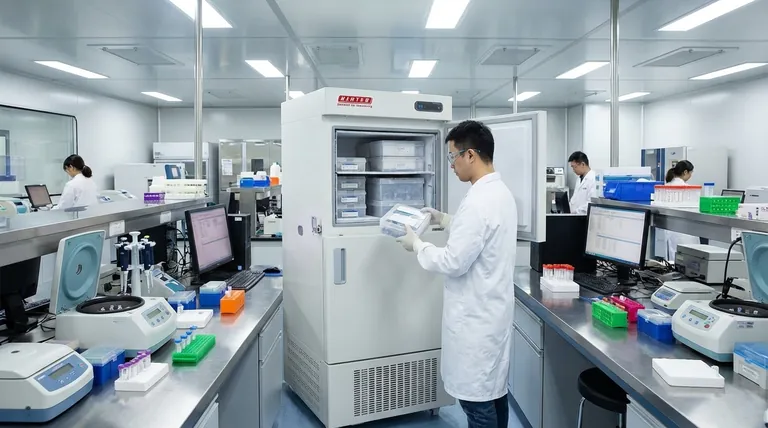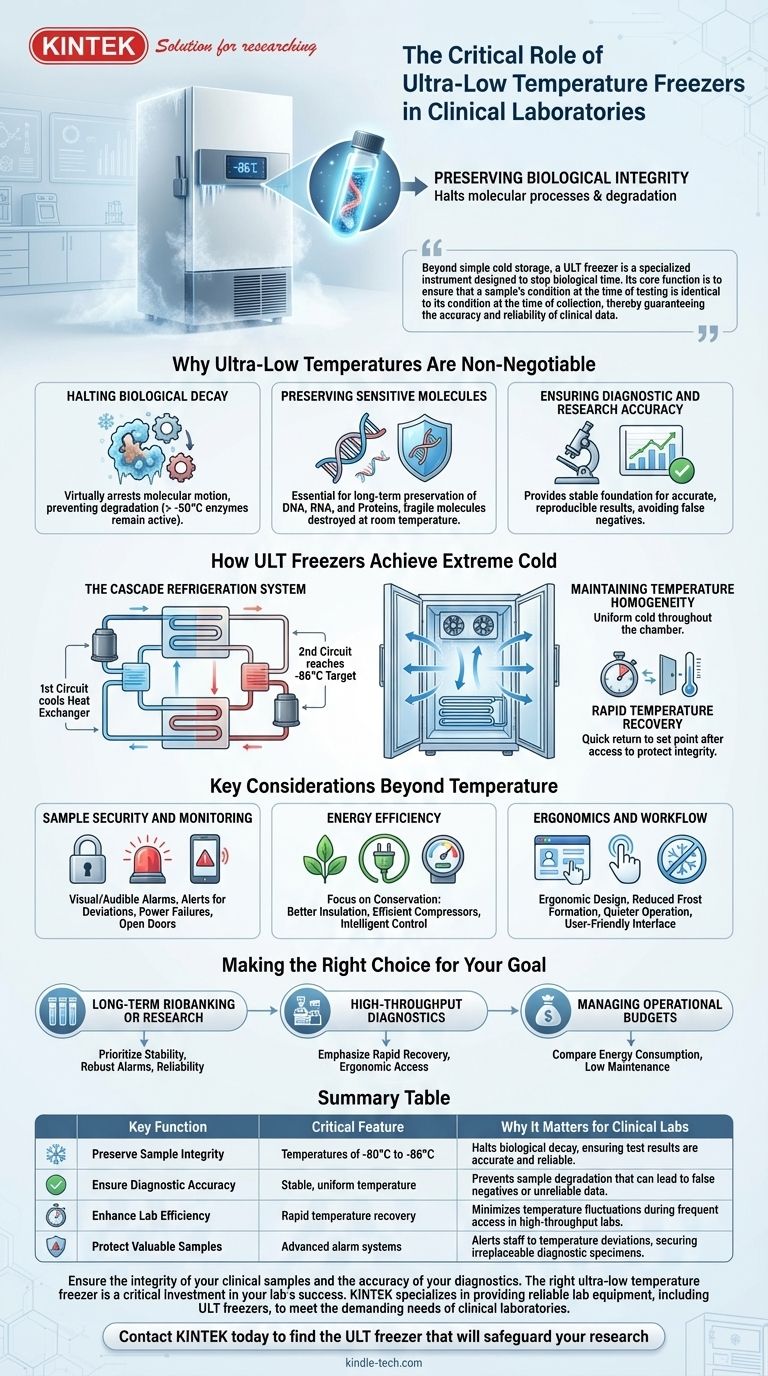In a clinical laboratory, an ultra-low temperature (ULT) freezer serves one primary, critical role: preserving the biological integrity of invaluable samples over long periods. These freezers are essential for storing diagnostic specimens like blood, plasma, serum, and tissues, which contain vital information for disease diagnosis, genetic testing, and medical research. By maintaining temperatures between -80°C and -86°C, they effectively halt the molecular processes that would otherwise degrade these sensitive materials.
Beyond simple cold storage, a ULT freezer is a specialized instrument designed to stop biological time. Its core function is to ensure that a sample's condition at the time of testing is identical to its condition at the time of collection, thereby guaranteeing the accuracy and reliability of clinical data.

Why Ultra-Low Temperatures Are Non-Negotiable
The value of a biological sample is tied directly to its stability. Standard refrigeration or even conventional freezers are insufficient for long-term storage because they only slow down, rather than stop, the enzymatic and molecular activity that causes samples to degrade.
Halting Biological Decay
At temperatures above -50°C, enzymes within cells and fluids remain active enough to slowly break down critical molecules like DNA, RNA, and proteins. A ULT freezer pushes the temperature so low that this molecular motion is virtually arrested, preventing degradation and preserving the sample in a state of suspended animation.
Preserving Sensitive Molecules
Molecules like RNA are notoriously fragile and can be destroyed in minutes at room temperature. For genetic testing, vaccine development, and molecular biology research, the long-term preservation of DNA, RNA, and proteins is fundamental. The ultra-low temperature environment is the only way to ensure these molecules remain intact for future analysis.
Ensuring Diagnostic and Research Accuracy
In a clinical setting, an incorrect result can have severe consequences. A degraded sample can lead to a false negative in a diagnostic test or produce unreliable data in a research study. ULT freezers provide the stable foundation required for accurate and reproducible results, which are the cornerstones of modern medicine.
How ULT Freezers Achieve Extreme Cold
These devices are far more complex than a household freezer. They rely on sophisticated engineering to reach and maintain extreme temperatures reliably, often for years at a time.
The Cascade Refrigeration System
Most ULT freezers use a cascade refrigeration system. This involves two separate refrigeration circuits working in tandem. The first circuit cools a heat exchanger, which in turn is used to cool the condenser of the second circuit, allowing the second refrigerant to condense at a much lower temperature and thus achieve the final -86°C target.
Maintaining Temperature Homogeneity
It is not enough to simply be cold; the temperature must be uniform throughout the entire chamber. ULT freezers use features like powerful air circulation fans and strategically placed evaporator coils to ensure temperature homogeneity. This prevents samples in different locations from experiencing temperature fluctuations.
Rapid Temperature Recovery
Every time a freezer door is opened, warm air enters and the internal temperature rises. A key performance metric is temperature recovery—the speed at which the unit returns to its set point. Fast recovery is critical in busy labs to minimize sample temperature cycling and protect their integrity.
Key Considerations Beyond Temperature
While temperature is the primary function, modern ULT freezers are evaluated on a range of factors that impact laboratory operations, sample security, and budget.
Sample Security and Monitoring
The contents of a ULT freezer can be irreplaceable. For this reason, built-in visual and audible alarms are standard features, alerting staff to temperature deviations, power failures, or an open door. This provides an essential layer of security for high-value samples.
Energy Efficiency
ULT freezers are energy-intensive devices that run 24/7. Modern designs increasingly focus on energy conservation through better insulation, more efficient compressors, and intelligent control systems. This not only reduces operational costs but also lowers a laboratory's environmental footprint.
Ergonomics and Workflow
Practical design features significantly impact daily lab work. These include ergonomic handles for easy opening, heated pressure release valves that prevent vacuum seals, and interior designs that reduce frost formation. A user-friendly interface and quieter operation also contribute to a more efficient and pleasant laboratory environment.
Making the Right Choice for Your Goal
The ideal ULT freezer depends entirely on the specific needs and priorities of your clinical laboratory.
- If your primary focus is long-term biobanking or research: Prioritize models with the best temperature stability, robust alarm systems, and a proven record of reliability.
- If your primary focus is high-throughput diagnostics: Emphasize rapid temperature recovery after door openings and an ergonomic design that facilitates quick access to samples.
- If your primary focus is managing operational budgets: Carefully compare the energy consumption ratings and look for models with low maintenance requirements.
Ultimately, selecting the right ULT freezer is a direct investment in the certainty and reliability of your clinical results.
Summary Table:
| Key Function | Critical Feature | Why It Matters for Clinical Labs |
|---|---|---|
| Preserve Sample Integrity | Temperatures of -80°C to -86°C | Halts biological decay, ensuring test results are accurate and reliable. |
| Ensure Diagnostic Accuracy | Stable, uniform temperature | Prevents sample degradation that can lead to false negatives or unreliable data. |
| Enhance Lab Efficiency | Rapid temperature recovery | Minimizes temperature fluctuations during frequent access in high-throughput labs. |
| Protect Valuable Samples | Advanced alarm systems | Alerts staff to temperature deviations, securing irreplaceable diagnostic specimens. |
Ensure the integrity of your clinical samples and the accuracy of your diagnostics. The right ultra-low temperature freezer is a critical investment in your lab's success. KINTEK specializes in providing reliable lab equipment, including ULT freezers, to meet the demanding needs of clinical laboratories. Our experts can help you select the perfect model for your specific application—whether it's for long-term biobanking, high-throughput diagnostics, or managing operational costs. Contact KINTEK today to find the ULT freezer that will safeguard your research and ensure your results are beyond reproach.
Visual Guide

Related Products
- 58L Precision Laboratory Ultra Low Temperature Upright Freezer for Critical Sample Storage
- 108L Vertical Ultra Low Temperature ULT Freezer
- 508L Advanced Vertical Ultra Low Temperature Freezer for Critical Laboratory Storage
- 708L Ultra Low Temperature Freezer High Performance Laboratory Freezer
- 208L Advanced Precision Laboratory Ultra Low Temperature Freezer for Cold Storage
People Also Ask
- What temperature range do Ultra-Low Temperature (ULT) freezers typically maintain? Preserve Your Samples from -40°C to -86°C
- What temperature range do Ultra-Low Temperature freezers maintain? The -80°C Standard for Sample Integrity
- What are ultra low temperature freezers used for? Preserving Critical Biological Samples for Decades
- What is ultra-low temperature freezing and what is its primary purpose? Preserve Biological Samples for Years
- What are the key construction features of ultra low temperature freezers? Essential Design for Protecting Critical Samples



















